Abstract
Civil society engagement is important for enabling urban systems transformations that meet community needs. The development of Future Earth Australia’s Sustainable Cities and Regions: A 10-Year Strategy for Urban Systems was underpinned by cross-sectoral workshops in 7 Australian urban areas and interviews with key stakeholders to create a shared vision of both current and desired future urban structure and policy. We then created an online survey to gauge broader community feedback on the vision which emerged from these workshops and interviews, to compare their outcomes with the views of community members who could be directly impacted by urban decision-making. The survey consisted of 35 questions, which were shaped by the issues emerging from the workshops and interviews. The sample was self-selected, and the 641 respondents represented a cross-section of individuals interested in sustainable cities. Our survey results supported and expanded on the major conclusions of FEA’s National workshop and interview processes, including the need to develop transparent and responsive decision-making processes, limit waste and pollution and develop effective housing and transport alternatives with mixed-use neighborhoods and adequate green space.
1. Introduction
The growth of transformative theory and action for global urban environments is well recognised [1]. Cities, central to urban systems, can and should demonstrate leadership in adopting and enabling sustainability policies and practice [2]. The success of such policies and practices is demonstrated where a connected, networked approach is adopted [3,4]. Ideally, these approaches are cognisant of scale (particularly regional) and of ‘shifting diversity, connectivity and complexity’ in urban systems and in light of living in the Anthropocene [5]. In Australia, scholars have widely acknowledged the sustainability challenges for our largely sprawled urban centres. Despite the utility [6] and apparent strong liveability performance of some Australian cities, for example Melbourne [7], Australia remains largely dependent on car travel. Economic growth is focused largely in urban and metropolitan centres where income disparities and housing affordability remain ongoing issues ([6,8,9,10] as it does elsewhere in the world [11]).
Among all this knowledge, there remains a clear need to capture and account for the lived experiences of citizens in urban environments. Such perspectives are not always well represented in the literature. Citizen perspectives studies offer critical insights into gaps between what researchers and governments think citizens (and therefore societies) want in their urban environments and their true preferences. In doing so, such perspectives provide opportunities to better identify and then leverage investments and outcomes that may aim to address these gaps. In addition, scholars and practitioners alike need to get much more creative when imagining our collective futures [12]. Complementing this is the utility of transdisciplinary networked urban innovation hubs—that are open to civil society and sectors beyond research, development and government. These warrant closer consideration and appreciation by the academic community [4,13]. This paper offers a unique study of citizen perspectives to inform urban systems transformation in and through networked hubs in Australia.
To support and direct urban transformations, it is important to engage a wider range of actors than urban planners and academics. To achieve the goal of more inclusive and responsive planning and governance, decision-making processes should engage the public more directly. Therefore, appropriate collation and assessment of community preferences for urban and regional development remains a significant challenge and opportunity for both scholars and urban practitioners alike [14]. This paper adopts a novel approach to systematically access and then assess these preferences. Expert surveys, workshops and design charettes have created trans-disciplinary urban strategies in other contexts [15,16,17]. However, comparing these findings with broad public opinion surveys ensures urban planning is more sensitive to the needs of its stakeholders. To create a truly coordinated strategy, stakeholders, experts, and citizens should each contribute their unique experience and knowledge to the planning process [18].
This paper builds on a series of workshops hosted by Future Earth Australia (FEA) in 2018–19, and several key stakeholder interviews carried out in parallel. These were used to inform a report titled Sustainable Cities and Regions: A 10-Year Strategy for Urban Systems (National Strategy) [4]. Urban scholars, practitioners and other stakeholders from around Australia worked towards creating consensus on a ten-year plan for enabling cities and regions to make substantial progress in achieving the Sustainable Development Goals by 2030. The objective of these processes was to create relevant and responsive knowledge and governance of cities, based on collaboration and inclusion [4].
The citizen survey is one input into the FEA urban initiative which helps to develop ongoing national urban strategies and recommendations. It was complementary to other FEA engagement processes, by providing the potential to reach a broader range of participants and to quantify, compare and prioritise their perceptions. However, due to timing and resource constraints, this sample is self-selected. This means that, as with the workshops, people who are already interested in and engaged with urban development issues are significantly overrepresented relative to the general population. While this sample has some similarities to the population participating in the workshops, it primarily engages citizens rather than professionals and/or experts from the organisations represented in the workshops. Therefore, the survey tests the urban visioning approach while determining the preferences of a relatively highly engaged subset of citizens. Further research could lead to broader random samples, which could be repeated over time given the dynamic nature of urban development. This would illustrate community-wide needs and desires across spatial and temporal scales.
Using community consultation or opinion surveying is popular at the project or metropolitan-scale [16,19,20,21,22,23,24]. This aligns local planning decisions with people’s contextual preferences. For example, a survey in South Africa compared public opinion on public transport issues with existing policy goals and implementation strategies [25]. Our survey aimed to achieve similar goals at metropolitan and national scales. Our survey differs in that it compares policy visions for the future, rather than existing interventions.
On this broader scale, questionnaires of holistic, desired futures have also successfully informed policy directions. For example, the Chicago Metropolis 2020 project collected expert and public opinions to formulate a set of shared goals for the metropolitan region [26]. Within Australia, Chambers et al. [27] conducted a public opinion survey of four economic and social scenarios, based on expert framing of plausible futures and policy directions. This approach was consistent with preferences for urban sustainability and community wellbeing and useful for setting policy directions for the Northern Territory [28].
Similarly, the city of Newcastle, Australia, developed a community strategic plan, involving visions and objectives proposed and discussed through a range of in-depth community engagement processes. This closely aligns with our aim to integrate public visions and goals for cities with expert-initiated strategies and recommendations. We have examined urban preferences across Australia to better inform planning goals on a national level.
The survey provides a rich picture of how a particularly engaged cohort perceives urban development in their communities, which has implications for national and local strategies. It also evidences how surveys structured using the four enablers of transformation—shared visioning, aligned institutions, stakeholder and community engagement, relevant knowledge—can provide useful insights [14]. Therefore, this article and the survey it draws on makes several novel contributions. To our knowledge, there is no current equivalent to our framing and resultant survey within the Australian context. However, there is significant potential for further research by extending the survey to reflect the general population. This would allow us to understand how different groups prioritise issues. The urban transformation enablers are not specifically tied to Australian cities. Therefore, this concept could also be applied to other scales and in other contexts.
2. Materials and Methods
Future Earth Australia’s methodology for developing its annual strategies is distinguished by a bottom-up, transdisciplinary approach [29,30,31,32]. This emphasizes garnering knowledge across sectors and embedding sustainability practice, governance, knowledge-use and development into high-level policy documents. Effective stakeholder engagement requires integrating a range of considerations. In the context of this paper, we aimed to offer a range of mechanisms through which people can contribute.
Offering multiple means of engagement is critically important for capturing the diversity of lived experience, knowledge and values of stakeholders. The major methods eliciting input for national strategies are cross-sectoral consultation workshops and stakeholder interviews. For the FEA cities and regions consultation, up to 50 leaders in most major Australian cities and some towns, across government, non-government, private sector, Indigenous and civil society groups, were invited to consider long-term, collaborative strategies to achieve the Sustainable Development Goals.
Following consultation workshops, an expert reference group was tasked with reviewing the data, assessing gaps and incorporating insights into the National Strategy. In parallel with this, a subgroup of the expert reference group, along with additional volunteers, were tasked with designing and implementing a survey to elicit further citizen input. The survey questions were informed by the issues that emerged from the workshops and interviews. This allowed us to mirror the discussion topics and compare expert and public opinions.
As noted in the introduction, this initial survey applied a self-selected sampling method given timing and resource constraints. A pilot survey was sent to the Future Earth mailing list, and questions were refined based on feedback from the pilot survey. An invitation to take the online survey using SurveyMonkey was then sent out through an email invitation to Future Earth networks and advertised publicly in media publications [32]. 641 usable responses were received. This predictably attracted people who were already engaged in sustainable urban development issues or had enough time to complete the survey. Additionally, not all respondents answered all questions, further over-representing those who cared most about the issues being discussed. To determine differences between our sample and the Australian population, we included questions on age, gender, political persuasion, income, occupation, household size and location. We also used this information to determine if major differences in opinions exist between these groups to any of our questions. However, because the sample population already represents a specific subset of the population, the demographic groups within our survey do not fully represent those groups within Australian society as a whole. The sample sizes for many groups are also very low. Therefore, while some minor differences between demographic groups are observed and noted below, we do not attempt to determine the statistical significances of these differences as the results of this would not provide any conclusive evidence of differences in preferences between groups in Australian society as a whole.
Expert-initiated and guided framing combined with public opinion surveying is an effective way to broaden the discussion of issues that will likely affect cities in the future [15,33]. This approach develops recommendations that are based on relevant expertise and feasibly within government capabilities while drawing on a range of experiences and backgrounds to develop a rich picture of the applicable problems and solutions. A similar expert-initiated approach has been a viable method for indicator selection of neighbourhood sustainability assessment tools for cities in other parts of the world [17].
The survey questions are given in Supplementary Information (SI) and the full dataset of results is available on request from the first author. The questions were divided into 4 groups, reflecting the four enablers of urban transformation used to help frame the workshops and interviews [4].
- (1)
- Visioning: The future of your city/town/region
- (2)
- Institutional design and governance: Roles of various decision-makers
- (3)
- Stakeholder engagement: Your involvement in your city/town/region issues
- (4)
- Knowledge: Need for relevant supporting information/knowledge
A large number of respondents also left additional comments under three free form questions. These enhanced the statistical findings and reaffirmed that the issues identified cover a wide range of interconnected urban systems.
Our method of analysing the qualitative data was to determine preliminary themes in the comments. Then, we tallied the responses which mentioned those themes. 327 comments were left for the question ‘Please state any other ideas that could lead to better outcomes for your city/region/town’. 158 comments were left for the open comment question in the section on the roles of various decision-makers influences on the planning system. 212 comments were left for the question ‘Please state any other specific issues for which you think it would be helpful to have better knowledge’.
3. Results
641 people answered the survey to completion. This does not include 74 people we excluded who began the survey by submitting their location but did go beyond that. The general demographic characteristics of this sample and how they compare to the Australian population are provided below.
Gender
Our sample captured a representative distribution of Males (46.8%) and Females (51.1%) with 2.1% of respondents electing not to answer. This is fairly similar to the national percentages of 49.2% Male and 50.8% Female [34].
Location
As expected, the geographic distribution of respondents clustered around major cities (Figure 1). Within major cities, we had a relatively uniform spread among inner-city and suburban neighbourhood residents (Figure 2).
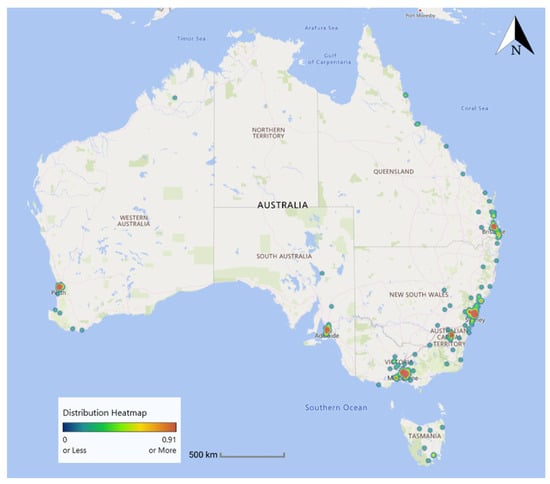
Figure 1.
Geographic distribution of respondents across Australia.
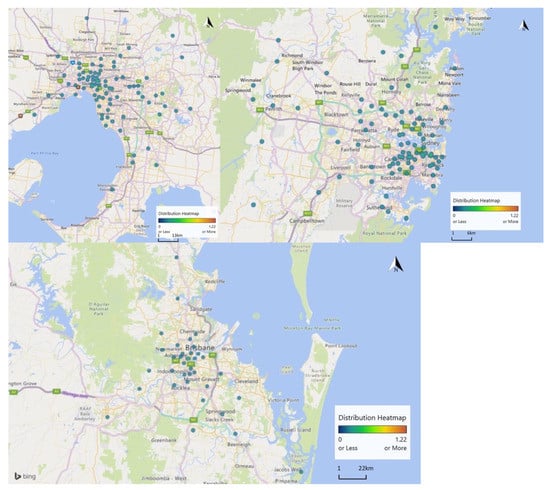
Figure 2.
Example geographic distribution of respondents within major cities: Melbourne (top left), Sydney (top right) and Brisbane (bottom).
Age
As shown in Figure 3, our survey over-represents ages 35–74 and under-represented ages below 24 and over 75 compared with census data. This is to be expected since children and young adults along with seniors over 75 are less likely to engage with a survey of this kind.
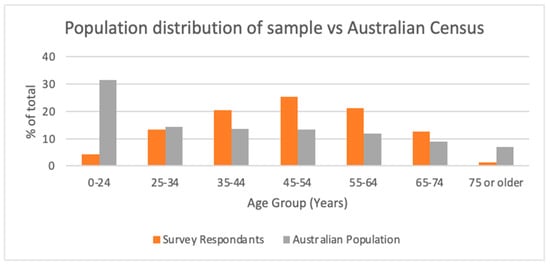
Figure 3.
Population distribution of sample population and Australian Census.
Indigenous engagement
Our sample under-represented Aboriginal and Torres Strait Islanders. The national proportion of these groups is 3.3% [35]. In our sample, only one respondent identified as Aboriginal or a Torres Strait Islander. This represented 0.2% of the sample.
Country of origin
73.3% of respondents were born in Australia, which is representative of the national proportion of 73.7%.
Commuting
68.4% of Australians nationally commute by private car [36], compared to 45.9% in our study (Figure S1). This is likely due to our sample capturing more inner-urban and environmentally conscious residents. Despite this, cars still dominated the transport choices of our sample population, speaking to the dependency on cars in Australian cities.
Political preference
Our survey over-represented Greens and Independent voters and under-represented Liberal/National voters (Figure 4). Respondents were almost six times less likely to support the Liberal-National Party (LNP) than Australians voting in the previous election. This may be a reflection of the greater interest in planning in general among Labor, Greens, and independent voters, or the audience of the mailing list and media publications that the survey was sent out through.
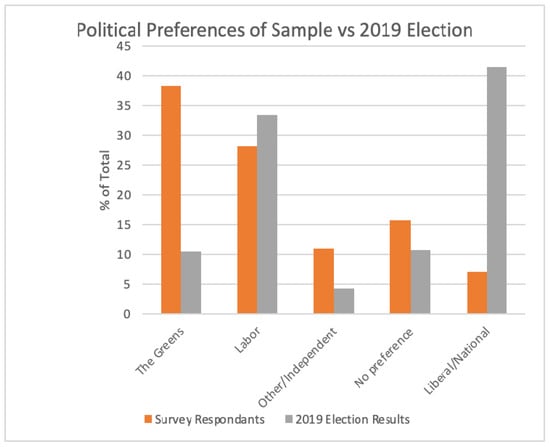
Figure 4.
Political Preferences of Sample population vs. 2019 Election results.
Income and education
While we captured a range of professions, our survey over-represented high-income and highly educated individuals. Those working in policy and urban design fields were also sightly over-represented. Again, this is likely due to the methods used to advertise the survey. Next, we briefly describe the responses to our survey questions, in the four main groups described above.
3.1. Questions about the Future of Cities, Towns and Regions
Ranking Issues in the present and pathways to desired futures
Questions two, three and four focus on the current issues and future visioning themes raised in the workshops. Question 2 focuses on the challenges which cities now face (Figure 5). Question 3 focuses on what respondents see as most important to achieving their ideal city (Figure 6). Question 4 focuses on the policy approaches to achieve this vision (Figure 7). The responses to these three questions were unsurprisingly very similar.
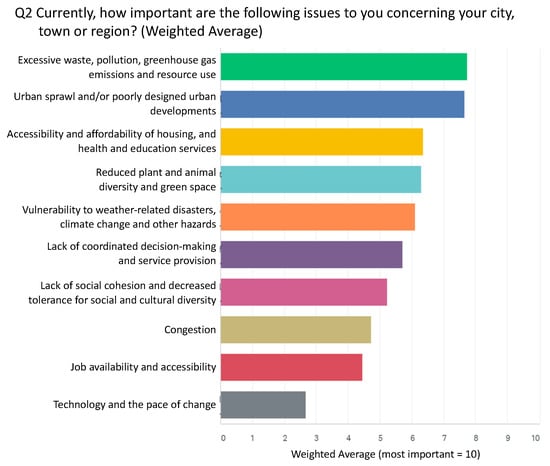
Figure 5.
Graph of responses to Question two.
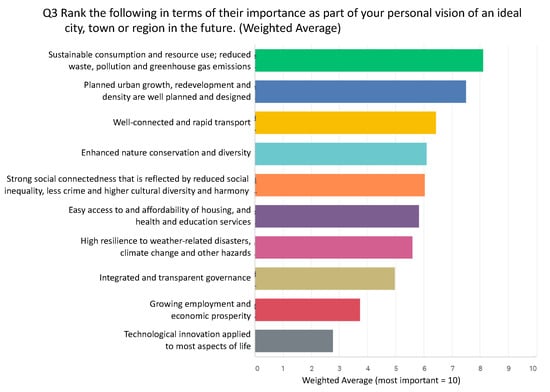
Figure 6.
Graph of responses to Question three.
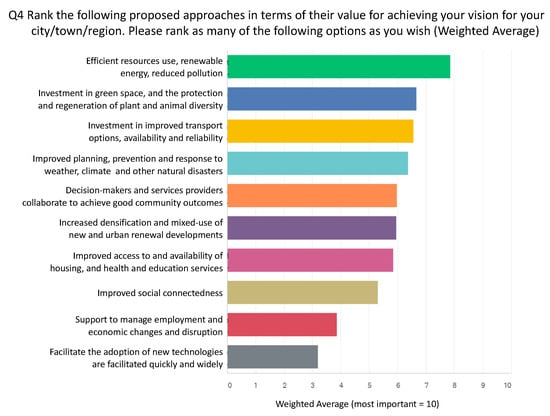
Figure 7.
Graph of responses to Question four.
Limiting all forms of waste and pollution (including GHG) through more sustainable consumption and production, and through improving urban planning and design (including less sprawl, greater density, more green space and better housing and transport) were the highest priority topics, both now and in people’s vision of the future.
- More effective alternative transport modes were also seen as crucial to people’s visions (Figure 6).
One of the few differences among the political groups within the survey was that LNP voters ranked congestion and employment slightly higher than the rest of the sample. However, those who commuted by car ranked congestion as their second-lowest priority in question 2. There was very little difference in responses between age groups, save for a slightly increased priority for social cohesion amongst older individuals. There were no significant differences between income brackets. However, due to the selection methods and the low sample size of certain demographic groups, these differences cannot be generalized to the Australian population as a whole.
Location preferences
Questions 5 and 6 determined locational preferences within the city. Inner Suburbs were by far the most desirable location assuming access to employment and amenities were equal (Figure 8). This held across almost all demographic groups. Respondents under 18 slightly favored the inner city over inner suburbs, although the sample size for this group is very small. Respondents over 65 ranked regional centres only slightly below inner cities. This means that the density mix and lifestyle of inner suburbs appeals to a broad range of people within our survey. Where access to work and amenities are considered, people preferred to live in the city over the suburbs (Figure 9). This speaks to a balance that must be achieved in urban land-uses. There was no strong consensus, meaning no type of community is ideal for everyone. Therefore, planners need to account for a variety of needs and preferences.
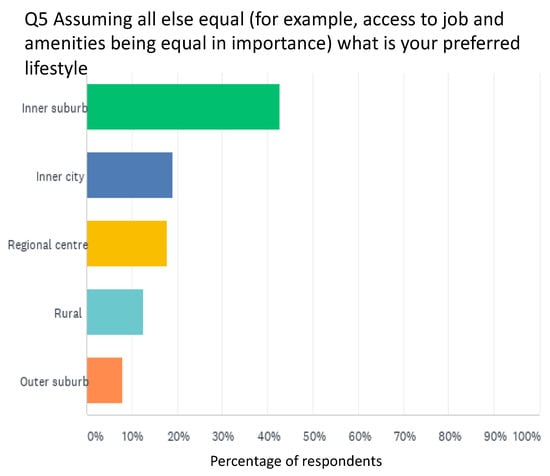
Figure 8.
Graph of responses to Question five.
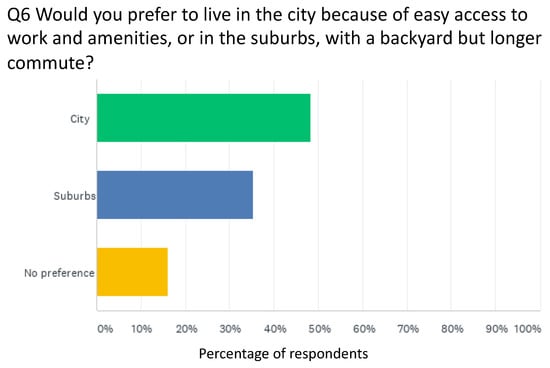
Figure 9.
Graph of responses to Question six.
Qualitative responses
The comments section for this component of the survey invited respondents to suggest further ideas that could lead to better outcomes for their areas. The main themes that emerged (with the number of related responses in brackets) were:
- Combat car dependence and congestion by investing in public and/or active transport infrastructure, electric vehicles and/or walkable neighbourhoods (76).
- Increase access and connection to nature through more green spaces, green infrastructure and/or urban agriculture (51).
- Address global and regional environmental challenges and/or create a regenerative/‘circular economy (45).
- Adopt a transparent, systems approach to governance that is sensitive to local community interests rather than developers (38).
- Decentralise office and/or commercial space to create mixed-use neighbourhoods of appropriate density (37).
- Rethink building codes and/or invest in more affordable, compact and/or sustainably designed housing models, including co-living (35).
- Create diverse, vibrant communities with equitable access to amenities (20).
- Ensure all levels of government and key stakeholders create shared visions and partnerships to avoid conflicting agendas (16).
- Improve urban design through better architecture standards and/or water-sensitive design features (12).
- Extend infrastructural growth outside of major centres to develop rural centres (11).
- Reduce population growth by discouraging migration to major cities (10).
- Long-term scenario planning and research (6).
- Urban heat island mitigation (5).
In the comments section of the survey, many respondents discussed density and land use. There was broad agreement that development should be mixed and compact, with access to green space. This type of urban form is most typical of inner suburbs in most Australian cities. One respondent brought up the need for a “focus on the middle ring and a hybrid between city and suburbs”. Inner suburbs tend to allow for vibrant, compact neighbourhoods without the intensity of city centres. However, people prefer cities to suburbs due to their easy access to work and amenities. This surpassed the desire of many individuals for a private backyard. Additionally, while most people agreed higher densities were necessary, many were also concerned by the height of buildings alienating residents. Therefore, the challenge for urban planners is to integrate various land uses with green space and walkable amenities dispersed throughout the city, while decentralising employment opportunities and amenities throughout the suburbs. This will allow cities to become more compact and liveable without the introduction of extremely tall buildings.
As also highlighted in the visioning questions, many people expressed worry over car-dependent urban sprawl, which did not serve the physical and social needs of residents. Therefore, they called for a shift from car-focused transport to active or public-transport alternatives. These were often imagined in conjunction with decentralised office and commercial space, as this would alleviate stress on the transport infrastructure in central areas and allow easy access to employment. Similarly, respondents saw expanded green space, better transport and compacted, mixed-use development as connected goals. Therefore, the various visions discussed throughout the paper are connected and feed into one another.
Many comments focused on the affordability, design standards and models of urban housing. Primarily, comments argued for stricter building codes to ensure housing was affordable and sustainable. There was also a large cohort who desired more communal housing arrangements, which would lower rents while repelling problems of loneliness. However, there was very little mention of access to other services such as health and education. This indicates that, while housing is a key concern for many, Australian cities already provide adequate access to other services, at least to the groups included in this survey.
While there was no mention of population growth or migration levels in our survey, a few respondents felt the uneven growth of cities in Australia was a central driver of other problems. 10 comments directly suggested controlling migration to large urban centres, while 11 desired more growth of industries and infrastructure outside of major centres. Both of these themes speak to the unbalanced growth patterns of Australian cities. Similar comments were made in the workshops. Those in Sydney, Melbourne and South East Queensland were concerned by over-development and congestion, while those in other cities were concerned by slow growth and employment rates. Due to the benefits of agglomeration, shifting development from major centres to smaller cities is difficult and costly. Nonetheless, there is a clear disconnect between the problems facing the three largest urban areas and the rest of the country.
Respondents from a variety of backgrounds also expressed concern over the siloed, or even corrupt, nature of urban development. There was broad consensus that the interests of developers and politicians were put ahead of public interest. Therefore, many respondents expressed a desire for more integrated and transparent governance, with more engagement of local citizen’s needs. A smaller group further suggested the use of scenario planning tools to engage stakeholders and collaboratively develop plans which provide a range of co-benefits. These comments reflect strong views on the perceived problems in current governance and decision making. Such governance and engagement issues are covered in more detail in the following Section 3.2 and Section 3.3. Collectively, respondents’ interests cover the whole spectrum of sustainable urban development issues.
3.2. Questions about the Roles of Various Decision-Makers
Questions 9, 10 and 11 focused on the institutions and groups which influence planning decisions (Figure 10, Figure 11 and Figure 12). Most respondents believed that the balance of power should be shifted in favour of citizens, experts and non-profits. 83% thought developers should have less influence, while 80% thought citizens should have more influence.
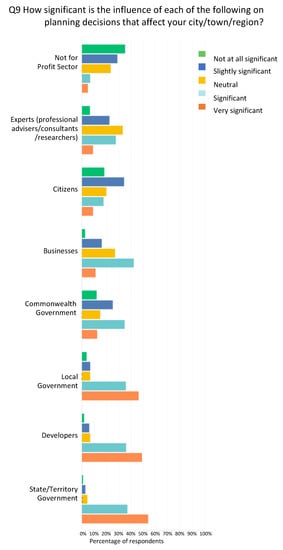
Figure 10.
Graph of responses to Question nine.
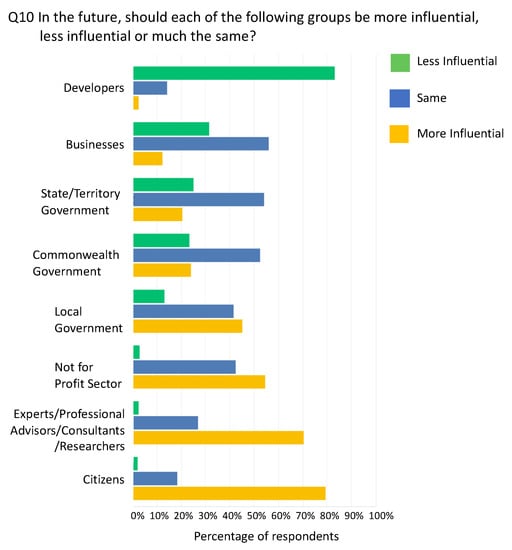
Figure 11.
Graph of responses to Question 10.
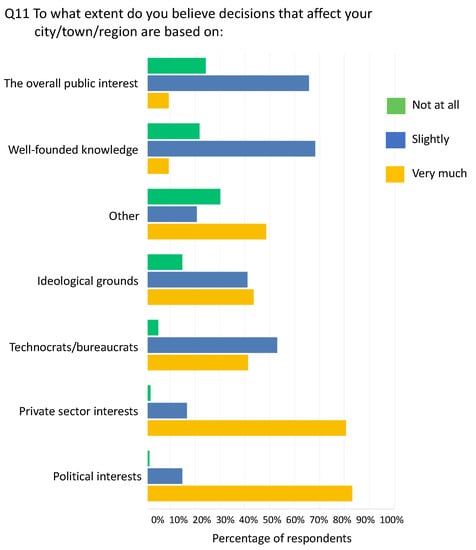
Figure 12.
Graph of responses to Question 11.
Strikingly, the order of which groups were thought to hold the most influence currently (Figure 10) was essentially opposite to the order of groups people thought should hold more power in the future (Figure 11). This means people in our survey want the reverse of the current power dynamic in urban decision-making. People generally agreed that decisions were based more on political and private interests rather than well-founded knowledge or public interest (Figure 12). While there were minor differences in responses between different demographic groups, all felt that the groups which currently hold power should hold less and that citizens should have more control over the planning process.
Qualitative responses
Respondents were able to leave additional comments on the roles of different actors in the planning system. Two themes emerged from these comments. First, the comments reflect strong views on the perceived problems in current governance and decision making. Respondents’ comments in this respect strongly overlapped with the qualitative comments provided in the later survey section (Section 3.4) on the availability and use of relevant information and knowledge to support urban decisions. To avoid repetition, those responses have been aggregated into the descriptions and numbers reported below, so that they cover both the respective roles and the knowledge used in urban decision making. The number of responses arguing for each point is in brackets.
- Relevant knowledge is currently available, but decision-making is heavily impacted by powerful interests, such as lobby groups, developers, and/or sometimes public servants. These override community interests and more diverse and relevant sources of knowledge (69).
- Decision-making processes too often do not reflect balanced values and objectives, lack relevant data, do not make full use of current knowledge, are not transparent enough and/or deviate from the agreed plan due to poor collaboration (50).
- Decision-makers have inadequate engagement with, understanding of and/or attention to community values and knowledge (37).
- There is a need for longer-term, more strategic, less siloed planning, with ongoing monitoring for accountability and review, and across political cycles, levels and siloes (15).
- Expert knowledge (including from public servants, the advisory professions and academics) is too often not sought and/or ignored and/or overridden (12).
- Decision-makers should draw more on best practice examples from overseas (2).
Second, the comments acknowledge the importance of changes to individual citizen choices and behaviours but see several prerequisites for this to occur at a large scale.
- Individual behavioural change requires structural changes first, primarily by governments at all levels and business, to provide better individual choices (43) eg in infrastructure, transport and housing options provided; influencing business marketing, supply chains, packaging and related consumerism; in food systems; in energy systems
- A better informed, educated and/or encouraged community could make better choices and/or gradually modify prevailing world views/values (15)
- More regulation and/or incentives may be needed to modify business and/or individual behaviours, e.g., on business resource use, waste and pollution; future-oriented construction codes; building/housing design standards and codes; tax incentives (10)
- Local community self-organisation, empowerment and/or action has the potential to influence individual behaviour (4)
- Some disadvantaged groups in society may have more limited options to act personally (3)
3.3. Questions about Involvement in Urban Issues
84% of respondents had been involved with some sort of planning consultation (Figure 13), but only 36% felt engaged in decision-making in their area (Figure S4). However, on average, respondents wanted to be 68% more involved (Figure S5) and most wanted to be more informed about the development plans in their area (Figure S7). Frequency tables for these questions are listed in the supplementary information section. These show how strongly people agreed or disagreed in their answers.

Figure 13.
Graph of responses to Question 15.
Community consultations were the most common and most desired method of engagement (Figure 13 and Figure 14). These processes occur before plans are fully formulated, allowing greater input from citizens. They are very localised, allowing for discussions of specific features of a development that would directly impact members of the community. Advisory groups, focus groups and citizens juries were the next most desired forms of engagement (Figure 14). These have the benefit of allowing for more nuanced discussions of larger-scale topics. Therefore, these positive aspects of community engagement should be enhanced. By far the two key reasons for a lack of involvement were a lack of publicity and inconvenient timing of meetings or consultation processes (Figure 15). Ultimately, this allows developers to dominate planning discussions.
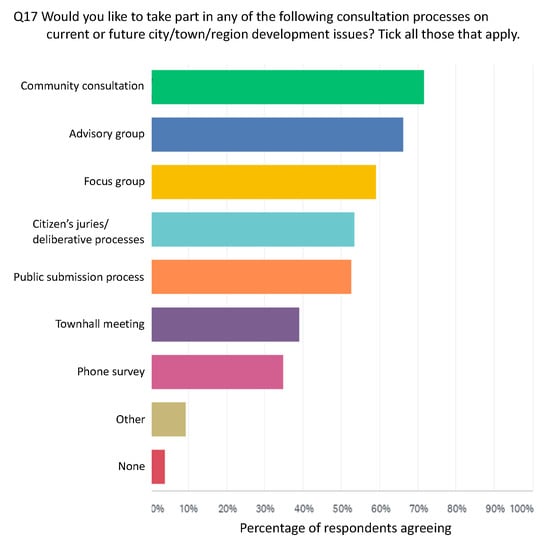
Figure 14.
Graph of responses to Question 17.
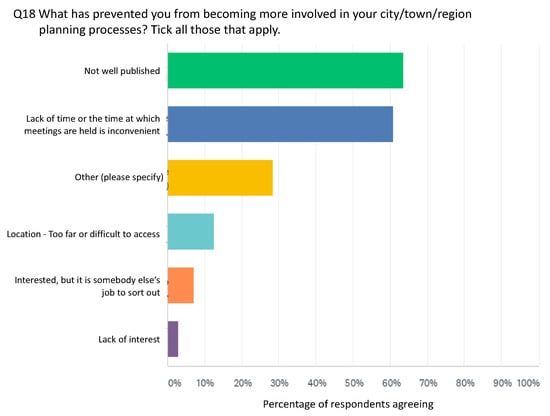
Figure 15.
Graph of responses to Question 18.
Qualitative responses
Changing community engagement practices was also a key theme in the comment section of the survey. Many respondents called for a systems approach that integrated local citizen’s interests and incorporated more community consultation. This was also called for in the National Strategy. However, there was also a feeling among many, including urban planners and public servants, that community consultation exercises currently fail to provide useful information which has a tangible impact on policy. Many additional comments on the question ‘What has prevented you from becoming more involved in your city/town/region planning processes?’ brought up the point that consultation processes are merely tokenistic. Respondents felt that voicing their opinions through the planning process was pointless because private interests ultimately dictate the direction of planning. One respondent worried that current consultation processes “tend to be part of maneuvering or manipulating people towards the desired outcome of the projects” rather than listening to and accepting the community’s opinions. As a result, in the qualitative responses, many respondents who had been involved in multiple community consultation processes stated that they were not engaged at all with decision-making in their local area. This was true across demographic groups, speaking to a worrying disconnect between the activities that planners use to engage citizens and their perceived contribution to urban planning in their area. Therefore, consultation processes should aim to facilitate public opinions feeding into usable data and policy actions.
3.4. Questions about Relevant Supporting Information and Knowledge
The survey indicates that overall, respondents rely slightly more on government websites and expert reports than on other media or social contacts. While the preferential order of social media, word of mouth and TV/Radio differed slightly between ages, education levels and political affiliations, all groups received most planning information from government websites and expert reports. Nonetheless, all these channels were quite widely accessed—perhaps indicating that all channels need to be used in public engagement strategies (Figure 16).

Figure 16.
Graph of responses to Question 22.
Respondents provided a wide range of responses on the extent of their awareness of relevant development plans—from the extremes of ‘not at all’ to ‘significantly’ (Figure S5). Overall, answers skewed to the ‘significantly’ end of the spectrum, likely resulting from our highly engaged sample population. However, there was a very clear majority who wanted to know more, again reflecting a strong desire of most respondents to be more involved in decision-making.
On the other hand, most respondents believed that current decision-makers already have access to the appropriate knowledge to effectively govern cities (Figure S7). Combined with the other responses, this suggests that many respondents did not feel able to access knowledge, despite believing that the relevant knowledge is available. Additionally, they did not trust decision-makers to make the best decisions on their behalf or in their interests.
Qualitative responses
The comments section for this component of the survey invited respondents’ views on what would be helpful to have better knowledge. Not surprisingly, these comments are consistent with the responses to the questions above, but they add significant depth and additional insights. The responses that directly related to the use of knowledge in governance and decision-making have, as already noted, been aggregated into the qualitative responses in Section 3.2. The additional themes that emerged concerning knowledge gaps and availability were (with the number of related responses in brackets):
- Several priority issues and desired solution spaces were identified, including areas for relevant knowledge development and use (83)—including climate change and/or energy (16); environmental issues (15); circular economy (8); population and/or urban/regional growth (10); social and cultural place-based character and liveability including public spaces (13); housing, transport and jobs (18); water capture and retention (1); food security (1); health/education services (1).
- Knowledge bases, capabilities, networks and/or learning need to be much better coordinated and developed (17).
4. Discussion
While there was variation in responses, it is possible to summarise, from the analysis in Section 3, a very strong overall narrative. The respondents’ priority issues in their future urban visions, as summarised above, are supported by several other research studies. Australian cities create a considerable amount of pollution, waste and greenhouse gas emissions [37,38]. Therefore, planning cities in a way that limits these outputs is an important consideration. However, it might be considered surprising that sustainable resource use was ranked so highly by citizens, as it could be seen as having a less immediate and direct impact on people’s daily lives than other factors. Possibly, this cohort is more attuned to or interested in such issues than the overall public. While Australian cities have ambitious goals for reducing waste and emissions, they have achieved limited shifts towards a circular and pollution-free economy in practice. Within our sample, it was seen as the most critical pathway towards creating ideal future cities, and certainly, there is significant potential for improvements in waste and emissions management in Australian cities to develop a more circular economy.
Planned urban growth of denser, mixed-use urban spaces was a very common desire. Interestingly, while well planned, dense urban growth was considered the second-most important factor for people’s visions for their area (Figure 6), increased mixed-use densification was the sixth-most preferred strategy for achieving this vision. This points to a sentiment that increasing density does not equate to well-planned and designed urban space on its own. Rather, policies for improved environmental sustainability, housing, transport and green space should complement more compact, mixed-use development.
The focus on alternative transport modes also aligns with conventional urban planning knowledge. The benefits of reliable public and active transport networks are well understood. In the United States, Chetty and Hendren [39] found that commute times were the most important factor in the odds of escaping poverty. Car-dependent urban planning is a driver of many other urban issues, such as urban sprawl, congestion, limited social connectedness and increasing greenhouse gas emissions [40,41,42]. Improving urban transport networks was seen as integral to solving many of the above key urban challenges while creating social and environmental co-benefits.
Investment in greenspace and biodiversity was also a very important factor for achieving people’s visions (Figure 7). The social, health and climate benefits of green space in cities are well-documented [43,44,45,46,47]. However, Australian cities are thought to fall below current guidelines for access to greenspace. Therefore, this is a potential area for improvement in future planning.
The lowest priority topic was technological innovation (Figure 5, Figure 6 and Figure 7). The survey results show that the Information and Communications Technology (ICT)-integrated urban design principles of ‘smart cities’ are not as important to this cohort as other aspects of an urban transformation. The term ‘smart city’ is fuzzy and the concept is generally based on the idea of adopting new technologies to develop more effective urban infrastructure, services and resource allocations [48]. However, smart city projects have been criticised for being unnecessary, unreliable and spatially unequal [49,50]. This is in line with the responses in our survey. This does not mean technology has no role in improving cities. However, as one respondent pointed out, in many parts of Australia the challenge is “not about new technology, [but] simply access to existing infrastructure”. Technological innovation in cities should not be the goal in itself. Our sample felt that the benefits of smart city design were less important than investing in housing, transport and environmentally conscious design, before fixing what is not broken. Essentially, Australian cities cannot simply rely on technological innovation to solve the problems outlined above. However, smart city innovations may prove crucial as a means to solve these challenges and should therefore not be entirely overlooked. New technologies should be integrated into other urban projects which tackle the roots of environmental, social and economic issues. Thus, technology can and should serve the visions outlined above, rather than driving urban form and function.
Increasing employment and managing economic changes and disruptions were both ranked as the second-lowest factors in Figure 5 and Figure 6. Given the level of rhetoric around creating economic prosperity and employment in Australian cities, it is surprising that it ranked among the lowest-priority topics, even among LNP voters in our sample. There are several possible reasons for this. First, the self-selected sample may have failed to include people who are concerned about their own employment status. Also, those whose livelihoods are the most sensitive to economic instability may be less likely to spend time engaging with a voluntary survey. Second, respondents may recognise that urban developments which aim to promote economic growth without considering other factors tend to create external costs and an uneven distribution of benefits without necessarily increasing genuine and equitable prosperity [51].
While the above elements of the survey findings dealt with the visioning of urban futures the other three sections of the survey deal with the processes of urban decision-making, stakeholder engagement and knowledge development. There was a general desire to enhance integrated urban strategies, to significantly rebalance decision influence towards citizens, community groups and Non-Government Organisations, including through more open and meaningful engagement processes, and incorporate community and expert knowledge and community values more overtly in decision-making.
These findings align with the work of other scholars (i.e., [52]) that highlight that governments can view the formal planning process as a barrier to housing and related urban investment and therefore to economic growth. Government agendas tend to reflect industry narratives in Australia and around the world. Consultations are circumscribed by the government’s implicit preferences [53]. Therefore, poor and disadvantaged groups are often unable to engage with the planning processes in a meaningful way [54]. Mahjabeen et al. [54] provide recommendations to improve this situation and integrate real participation in Australian urban planning practices. These suggest stronger legislation on how to structure community consultations.
The themes that emerged from our survey are broadly consistent with those that emerged from the workshops and interview processes conducted under the Future Earth Australia urban initiative. These processes had participants that may well have an overall profile relatively similar to the survey cohort. The workshops and interviews understandably delved deeper into most issues and provided a somewhat richer picture of future visioning issues. On the other hand, the survey gave a more quantitative assessment of the relative significance of issues. If anything, the survey cohort expressed even more strongly the concerns over the perceived inadequacies of governance and engagement, whilst the workshops and interviews identified more clearly some of the current policy, governance, engagement and knowledge gaps and possible solutions. Therefore, whilst the findings are consistent, they also provide complementary perspectives. These results are also consistent with the recommendations of the UN’s New Urban Agenda [55], as well as many of the targets of SDG 11.
Other citizen surveys have been conducted on related urban issues in Australia. For example, Chambers et al. [27] discuss Australian political scenarios. Stone et al. [56] surveyed Australians’ housing aspirations. Internationally, a range of studies have used citizen surveys [16,19,20,22,23,24,25,33,57]. However, few have attempted to elicit individual citizen’s views on such a broad range of urban transformation issues.
Stone et al. [56], a survey of Australian housing aspirations, provides a good example of how our survey and more topic-specific surveys might be used in a complementary way. The two surveys’ responses intersect at some key points. For example, both seem to indicate that most respondents are relatively happy with their immediate housing situation, at least in the immediate or 1–2 year short term. Looking forward, there is a desire in both surveys for a greater variety and choice of housing options and especially more compact and affordable dwelling options; and that there are opportunities to encourage decentralization of living especially to regional towns and centres. Our survey allows such findings to be set in the context of a much broader range of urban issues and perceptions, whilst the Stone et al. survey can pursue much more detail in the specific housing issues (e.g., how housing aspirations vary across individuals’ life cycles).
In brief, our survey should be seen as one of several desirable and complementary approaches to co-designing sustainable urban futures. Most importantly, the survey provides a first step in establishing the views of individual citizens on the broad range of issues relevant to national and local urban strategy development, from the perspective of their lived experience as citizens.
5. Conclusions
The results of this public opinion survey complement and expand on the expert workshop’s conclusions, which included the following key insights [4]:
- -
- Density is important, but so is liveability
- -
- Liveability has a different emphasis for each person but includes green space, access to services, employment and transport. The consensus is that we must respond to climate change, through actions that both reduce the rate of change and adapt to it
- -
- People both in cities and outside them want explicit attention paid to how urban areas and their hinterlands interact and depend on one another
- -
- Economic regeneration and notions of a circular economy are seen as essential elements of a “transformed” city.
The results of this public opinion survey complement the FEA urban initiative’s interview and workshop processes. While the interviews and workshops framed the issues and potential solutions for Australian cities, the survey allowed us to determine which strategic urban issues had relative weight in the minds of a broader group of engaged citizens. This allowed us to understand which issues were considered more important than others. This information is key for the development of sustainable transformation policy agendas. The survey illustrated the process challenges in urban governance and decision-making, creating meaningful community engagement and developing and using relevant knowledge.
The self-selected nature of the survey favoured respondents who were more likely to care about the direction of urban planning. Although this cannot be taken as a representation of the broader Australian public’s views on urban issues, it provides useful insights into the issues which are important to a concerned section of the population. It is therefore an example of how stakeholder and civil society participation can be incorporated into urban planning.
Nonetheless, the survey could be extended to a broader range of citizens, and also repeated over time to help identify any changes in citizens’ views and the drivers of change. For example, the survey was completed before the Covid-19 crisis. It would be useful to understand if such a major disruption has materially changed people’s priorities. The exercise has also shown the value of surveying citizens on the full range of urban transformation issues to complement more narrowly focused but deeper topic-based surveys.
The survey reaffirmed that this cohort of citizens feel their voices are not being heard. Overwhelmingly, respondents believed decisions were made in the interests of developers, businesses and governments’ political agendas. A representative sample of public opinions, broad engagement in scenario planning, investment in transdisciplinary hubs, and deliberative democracy approaches are crucial next steps towards developing urban policies which meet the needs and desires of residents. This survey showed that many members of the public would like to engage more with the planning processes which affect their daily lives. Therefore, there is a need for more sophisticated research into public opinions on urban issues and more effective ways to engage the public, as it is these citizens who will live with the outcomes delivered by urban governance.
Supplementary Materials
The following are available online at https://www.mdpi.com/article/10.3390/su13094749/s1, Figures S1–S8, full list of Survey Questions.
Author Contributions
Conceptualization, R.C., T.O. and R.W.; methodology, all; analysis, M.C.-v.d.B., S.C., R.W.; writing—original draft preparation, M.C.-v.d.B.; writing—review and editing, R.C., R.W., T.O., E.R.; visualization, J.L., H.H.; funding acquisition, T.O. All authors have read and agreed to the published version of the manuscript.
Funding
This research was funded by Future Earth Australia as part of their ‘Sustainable Australian Cities and Communities’ project.
Institutional Review Board Statement
Ethical review approval for this study was part of a larger Future Earth Australia project titled Sustainable cities and regions: 10-year strategy to enable urban systems transformation.
Informed Consent Statement
Informed consent was obtained from all subjects involved in the study.
Data Availability Statement
Full survey results are available by contact of the first author (milocostanza@gmail.com).
Conflicts of Interest
The authors declare no conflict of interest.
References
- Frantzeskaki, N.; McPhearson, T.; Kabisch, N. Urban sustainability science: Prospects for innovations through a system’s perspective, relational and transformations’ approaches. Ambio 2021. [Google Scholar] [CrossRef]
- Irvine, S.; Bai, X. Positive inertia and proactive influencing towards sustainability: Systems analysis of a frontrunner city. Urban Transform. 2019, 1, 1. [Google Scholar] [CrossRef]
- Bai, X.; Colbert, M.L.; McPhearson, T.; Roberts, D.; Siri, J.; Walsh, B.; Webb, B. Networking urban science, policy and practice for sustainability. Curr. Opin. Environ. Sustain. 2019, 39, 114–122. [Google Scholar] [CrossRef]
- O’Donnell, T.; Webb, R.; Dodson, J.; Robson, E.; Auty, K.; Stafford Smith, M.; Ryan, C. Sustainable Cities and Regions: 10 Year Strategy to Enable Urban Systems Transformation; Future Earth: Canberra, Australia, 2019. [Google Scholar]
- Elmqvist, T.; Andersson, E.; McPhearson, T.; Bai, X.; Bettencourt, L.; Brondizio, E.; Colding, J.; Daily, G.; Folke, C.; Grimm, N.; et al. Urbanization in and for the Anthropocene. NPJ Urban Sustain. 2021, 1, 6. [Google Scholar] [CrossRef]
- Department of Infrastructure and Regional Development. State of Australian Cities 2014–2015; Infrastructure Australia Major Cities Unit: Canberra, Australia, 2015.
- Higgs, C.; Badland, H.; Simons, K.; Knibbs, L.D.; Giles-Corti, B. The Urban Liveability Index: Developing a policy-relevant urban liveability composite measure and evaluating associations with transport mode choice. Int. J. Health Geogr. 2019, 18, 14. [Google Scholar] [CrossRef] [PubMed]
- Daley, J.; Coates, B.; Wiltshire, T. Housing Affordability: Re-Imagining the Australian Dream; Grattan Institute: Carlton, Australian, 2018; ISBN 9780648230748. [Google Scholar]
- Phibbs, P.; Gurran, N. The role and significance of planning in the determination of house prices in Australia: Recent policy debates. Environ. Plan. A Econ. Space 2021. [Google Scholar] [CrossRef]
- Sarkar, S.; Phibbs, P.; Simpson, R.; Wasnik, S. The scaling of income distribution in Australia: Possible relationships between urban allometry, city size, and economic inequality. Environ. Plan. B Urban Anal. City Sci. 2018, 45, 603–622. [Google Scholar] [CrossRef]
- Galster, G.; Lee, K.O. Housing affordability: A framing, synthesis of research and policy, and future directions. Int. J. Urban Sci. 2021, 25 (Suppl. 1), 7–58. [Google Scholar] [CrossRef]
- Fazey, I.; Schäpke, N.; Caniglia, G.; Hodgson, A.; Kendrick, I.; Lyon, C.; Page, G.; Patterson, J.; Riedy, C.; Strasser, T.; et al. Transforming knowledge systems for life on Earth: Visions of future systems and how to get there. Energy Res. Soc. Sci. 2020, 70, 101724. [Google Scholar] [CrossRef]
- Newton, P.; Frantzeskaki, N. Creating a National Urban Research and Development Platform for Advancing Urban Experimentation. Sustainability 2021, 13, 530. [Google Scholar] [CrossRef]
- Webb, R.; Bai, X.; Smith, M.S.; Costanza, R.; Griggs, D.; Moglia, M.; Neuman, M.; Newman, P.; Newton, P.; Norman, B. Sustainable urban systems: Co-design and framing for transformation. Ambio 2018, 47, 57–77. [Google Scholar] [CrossRef]
- Newton, P.; Taylor, M. 23. Probable urban futures. In The Future of Urban Form: The Impact of New Technology; Routledge: London, UK, 1985; p. 313. [Google Scholar]
- Loures, L. Post-industrial landscapes as drivers for urban redevelopment: Public versus expert perspectives towards the benefits and barriers of the reuse of post-industrial sites in urban areas. Habitat Int. 2015, 45, 72–81. [Google Scholar] [CrossRef]
- Dawodu, A.; Cheshmehzangi, A.; Williams, A. Expert-initiated integrated approach to the development of sustainability indicators for neighbourhood sustainability assessment tools: An African perspective. J. Clean. Prod. 2019, 240, 117759. [Google Scholar] [CrossRef]
- Renn, O.; Webler, T.; Rakel, H.; Dienel, P.; Johnson, B. Public participation in decision making: A three-step procedure. Policy Sci. 1993, 26, 189–214. [Google Scholar] [CrossRef]
- Ewing, R. Asking transit users about transit-oriented design. Transp. Res. Rec. 2000, 1735, 19–24. [Google Scholar] [CrossRef]
- Balram, S.; Dragićević, S. Attitudes toward urban green spaces: Integrating questionnaire survey and collaborative GIS techniques to improve attitude measurements. Landsc. Urban Plan. 2005, 71, 147–162. [Google Scholar] [CrossRef]
- Bond, S.; Thompson-Fawcett, M. Public participation and new urbanism: A conflicting agenda? Plan. Theory Pract. 2007, 8, 449–472. [Google Scholar] [CrossRef]
- Kriese, U.; Bügl, R.; Scholz, R.W. Market Actors’ Views on Urban Family Living: Informing Urban Planning and Place Marketing in Preparation for Urban Transitions. Eur. Plan. Stud. 2013, 21, 204–231. [Google Scholar] [CrossRef]
- Jankowski, P.; Czepkiewicz, M.; Młodkowski, M.; Zwoliński, Z. Geo-questionnaire: A method and tool for public preference elicitation in land use planning. Trans. GIS 2016, 20, 903–924. [Google Scholar] [CrossRef]
- Schroeder, S. A Citizen-Defined Vision for the City’s Future. A New Contribution to the Discourse of Citizen Participation in Piura, Peru; IOP Conference Series: Earth and Environmental Science; IOP Publishing: Bristol, UK, 2020; p. 012063. [Google Scholar]
- Heyns, G.; Luke, R. South African public opinion on the state of urban transport: An appraisal of the achievement of policy objectives. WIT Trans. Built Environ. 2016, 164, 1–12. [Google Scholar]
- La Belle, J.; O’Connor, P.; Roccasalva, G. Chicago Metropolis Plans 2020. In The Future of Cities and Regions; Springer: Dordrecht, The Netherlands, 2012; pp. 19–43. [Google Scholar]
- Chambers, I.; Costanza, R.; Zingus, L.; Cork, S.; Hernandez, M.; Sofiullah, A.; Htwe, T.Z.; Kenny, D.; Atkins, P.; Kasser, T. A public opinion survey of four future scenarios for Australia in 2050. Futures 2019, 107, 119–132. [Google Scholar] [CrossRef]
- Chambers, I.; Russell-Smith, J.; Costanza, R.; Cribb, J.; Kerins, S.; George, M.; James, G.; Pedersen, H.; Lane, P.; Christopherson, P. Australia’s north, Australia’s future: A vision and strategies for sustainable economic, ecological and social prosperity in northern Australia. Asia Pac. Policy Stud. 2018, 5, 615–640. [Google Scholar] [CrossRef]
- Pohl, C.; Hadorn, G.H. Methodological challenges of transdisciplinary research. Nat. Sci. Soc. 2008, 16, 111–121. [Google Scholar] [CrossRef]
- Popa, F.; Guillermin, M.; Dedeurwaerdere, T. A pragmatist approach to transdisciplinarity in sustainability research: From complex systems theory to reflexive science. Futures 2015, 65, 45–56. [Google Scholar] [CrossRef]
- Rigolot, C. Transdisciplinarity as a discipline and a way of being: Complementarities and creative tensions. Humanit. Soc. Sci. Commun. 2020, 7, 1–5. [Google Scholar] [CrossRef]
- O’Donnell, T.; Webb, B.; Ryan, C.; Robson, E.; Dodson, J.; Auty, K. If We Want Liveable Cities in 2060 We’ll Have to Work Together to Transform Urban Systems. Available online: https://theconversation.com/if-we-want-liveable-cities-in-2060-well-have-to-work-together-to-transform-urban-systems-119235 (accessed on 21 April 2020).
- Burgess, J.; Harrison, C.M.; Limb, M. People, parks and the urban green: A study of popular meanings and values for open spaces in the city. Urban Stud. 1988, 25, 455–473. [Google Scholar] [CrossRef]
- Australian Bureau of Statistics (ABS). Regional Population by Age and Sex, Australia. Available online: https://www.abs.gov.au/statistics/people/population/regional-population-age-and-sex/latest-release (accessed on 25 May 2020).
- Australian Bureau of Statistics (ABS). Estimates of Aboriginal and Torres Strait Islander Australians. Available online: https://www.abs.gov.au/statistics/people/aboriginal-and-torres-strait-islander-peoples/estimates-aboriginal-and-torres-strait-islander-australians/latest-release (accessed on 25 May 2020).
- McCrindle. Getting to Work: The Great Australian Commute. Available online: https://mccrindle.com.au/insights/blogarchive/getting-to-work-the-great-australian-commute/ (accessed on 25 May 2020).
- Kaza, S.; Yao, L.; Bhada-Tata, P.; Van Woerden, F. What a Waste 2.0: A Global Snapshot of Solid Waste Management to 2050; World Bank Publications: Washington, DC, USA, 2018. [Google Scholar]
- Moran, D.; Kanemoto, K.; Jiborn, M.; Wood, R.; Többen, J.; Seto, K.C. Carbon footprints of 13,000 cities. Environ. Res. Lett. 2018, 13, 064041. [Google Scholar] [CrossRef]
- Chetty, R.; Hendren, N. The Impacts of Neighborhoods on Intergenerational Mobility: Childhood Exposure Effects and County-Level Estimates; Harvard University and NBER: Cambridge, MA, USA, 2015; pp. 1–144. [Google Scholar]
- Freilich, R.H. The land-use implications of transit-oriented development: Controlling the demand side of transportation congestion and urban sprawl. Urban Law. 1998, 30, 547. [Google Scholar]
- Hickman, R.; Ashiru, O.; Banister, D. Transport and climate change: Simulating the options for carbon reduction in London. Transp. Policy 2010, 17, 110–125. [Google Scholar] [CrossRef]
- Mccrea, R.; Walters, P. Impacts of urban consolidation on urban liveability: Comparing an inner and outer suburb in Brisbane, Australia. Hous. Theory Soc. 2012, 29, 190–206. [Google Scholar] [CrossRef]
- Dang, T.N.; Seposo, X.T.; Duc, N.H.C.; Thang, T.B.; An, D.D.; Hang, L.T.M.; Long, T.T.; Loan, B.T.H.; Honda, Y. Characterizing the relationship between temperature and mortality in tropical and subtropical cities: A distributed lag non-linear model analysis in Hue, Viet Nam, 2009–2013. Glob. Health Act. 2016, 9, 28738. [Google Scholar] [CrossRef] [PubMed]
- Fuller, R.A.; Irvine, K.N.; Devine-Wright, P.; Warren, P.H.; Gaston, K.J. Psychological benefits of greenspace increase with biodiversity. Biol. Lett. 2007, 3, 390–394. [Google Scholar] [CrossRef] [PubMed]
- Lee, A.C.; Maheswaran, R. The health benefits of urban green spaces: A review of the evidence. J. Public Health 2011, 33, 212–222. [Google Scholar] [CrossRef]
- Luck, G.W.; Davidson, P.; Boxall, D.; Smallbone, L. Relations between urban bird and plant communities and human well-being and connection to nature. Conserv. Biol. 2011, 25, 816–826. [Google Scholar] [CrossRef]
- Troy, A.; Grove, J.M.; O’Neil-Dunne, J. The relationship between tree canopy and crime rates across an urban–rural gradient in the greater Baltimore region. Lands. Urban Plan. 2012, 106, 262–270. [Google Scholar] [CrossRef]
- Albino, V.; Berardi, U.; Dangelico, R.M. Smart cities: Definitions, dimensions, performance, and initiatives. J. Urban Technol. 2015, 22, 3–21. [Google Scholar] [CrossRef]
- Cardullo, P.; Di Feliciantonio, C.; Kitchin, R. The Right to the Smart City; Emerald Group Publishing: Bingley, UK, 2019. [Google Scholar]
- Saxe, S. I’m An Engineer, and I’m Not Buying into ‘Smart’ Cities. The New York Times, 16 July 2019. [Google Scholar]
- Costanza, R.; Kubiszewski, I.; Giovannini, E.; Lovins, H.; McGlade, J.; Pickett, K.E.; Ragnarsdóttir, K.V.; Roberts, D.; De Vogli, R.; Wilkinson, R. Development: Time to leave GDP behind. Nat. News 2014, 505, 283. [Google Scholar] [CrossRef]
- Gurran, N.; Ruming, K. Less planning, more development? Housing and urban reform discourses in Australia. J. Econ. Policy Reform 2016, 19, 262–280. [Google Scholar] [CrossRef]
- Lahiri-Dutt, K. ‘I plan, you participate’: A southern view of community participation in urban Australia. Community Dev. J. 2004, 39, 13–27. [Google Scholar] [CrossRef]
- Mahjabeen, Z.; Shrestha, K.K.; Dee, J.A. Rethinking community participation in urban planning: The role of disadvantaged groups in Sydney metropolitan strategy. Australas. J. Reg. Stud. 2009, 15, 45–63. [Google Scholar]
- UN Habitat The New Urban Agenda. Available online: https://habitat3.org/the-new-urban-agenda/ (accessed on 24 March 2021).
- Stone, W.; Rowley, S.; Parkinson, S.; James, A.; Spinney, A. The Housing Aspirations of Australians across the Life-Course: Closing the ‘Housing Aspirations Gap’; Australian Housing and Urban Research Institute Limited: Melbourne, Australia, 2020. [Google Scholar]
- Qiu, F.; Wang, E.; Fan, M.; Liao, H.; Wang, L.; Huang, Z. A questionnaire case study of Chinese opinions on the haze pollution and economic growth. Sustainability 2018, 10, 1970. [Google Scholar] [CrossRef]
Publisher’s Note: MDPI stays neutral with regard to jurisdictional claims in published maps and institutional affiliations. |
© 2021 by the authors. Licensee MDPI, Basel, Switzerland. This article is an open access article distributed under the terms and conditions of the Creative Commons Attribution (CC BY) license (https://creativecommons.org/licenses/by/4.0/).